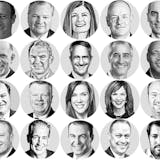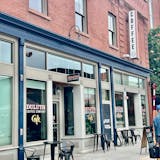We don’t expect beauty from gas stations, but we used to.
When stations started popping up in the 1920s, they chose historical styles, since that was the architectural vernacular of the era. A Spanish-style building with tiled roofs, a mock Tudor cottage, a bit of classical style as if you were feeding oats to your chariot horse instead of gas to your metal steed.
After World War II, a new style emerged: white and minimalistic.
All the big brands — Gulf, Texaco, Standard, Esso — went with the same style and shape, almost as if it was a Platonic ideal. Two big bays for service, a small office on the corner with stacks of oil cans and batteries and belts and filters, and two bathrooms around the corner. If it weren’t for the big sign on a pole in the corner of the lot, you might not have known which brand you were patronizing.
According to the ad campaign of the times, your family would be dressed entirely in white. The attendant who came out to pump your fuel and check your oil: spotless white, unmarred by oil or grease. The gas station itself: a gleaming box of alabaster perfection. It was a vision of prosperity and, just as important, cleanliness: You wouldn’t mar your clothes with oil, the bathrooms would be antiseptic and pristine.
The ads made getting gas look like a holy ritual, with Dad solemnly studying an unfolded manuscript devoted to the prophecies of St. Rand and St. McNally.
Eventually, though, new styles would compete for motorists’ attention.
In the 1960s, Phillips 66 introduced an audacious “batwing” canopy over the pump islands, a V-shaped overhang that pointed to the sky. A few can still be found around the city, but few, if any, are still Phillips stations.



